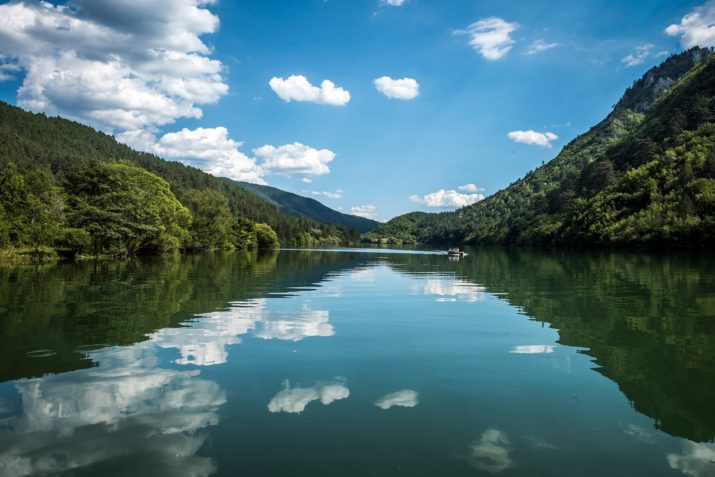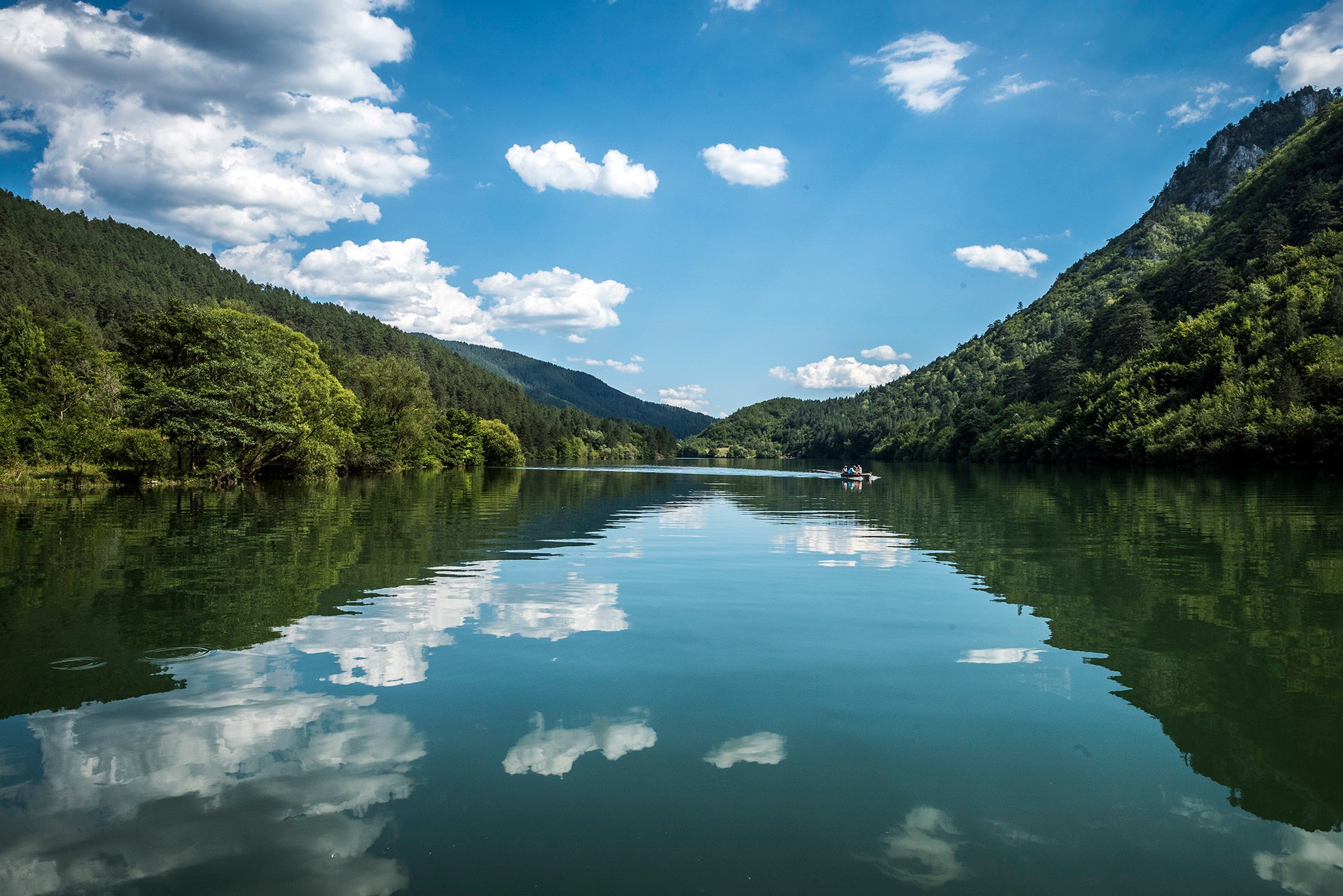
Riverine Struggles Against Plunder and Dispossession: Water Defenders in Postwar Bosnia-Herzegovina

This is part of our special feature, The Frontlines of Environmental Politics in Europe.
In the rugged and haunted lands of Bosnia-Herzegovina, rivers are places of extremes. Rousing of acute, aching love—the kind that inspires folk songs and popular devotion—rivers are often celebrated for their ability to ensure both survival and joy to the communities that live on their banks.[i] Not only does Bosnia bear the name of the eponymous river that runs through its geographic core, but in this heart-shaped country, rivers also double as national borders, including Una in the west, Sava in the north, and Drina in the east. However, despite their powerful symbolic role and growing environmental consciousness, Bosnian riverine landscapes also suffer from reckless destruction, be it from industrial or agricultural pollutants, new hydropower schemes, illegal construction, or the copious amounts of solid waste, whose collection is no longer organized in much of the country gutted by war and neoliberal transition.
Whether pristine or littered with plastic bottles and bags, Bosnian rivers remain a lifeline for many of its rural and urban settlements, providing drinking and irrigation water, a source of food and livelihood, and on occasion still, a form of transportation. And so, during the last several years, first slowly and then with growing fury, these waterways have also emerged as sites of new kinds of political friction and popular resistance, which have the potential to become the first cohesive, transethnic social movement Bosnia has seen in over twenty-five years since the end of the 1992-95 war. Like their counterparts in the neighboring Serbia, Montenegro and Albania, Bosnian river defenders have chiefly been organizing to contest the environmental harms embodied in the rush to build hundreds of small, and in some cases much larger, hydropower plants. The intent of these activists is to put a stop to a new generation of speculators looking to seize this vital form of wealth and capture its energetic potential, at the expense of both human and non-human forms of life that will be disrupted should those wild rivers be packed away into concrete pipes.
The last frontier of dispossession
It is thanks to this new form of extractive, unchecked capitalist expansion that Bosnian rivers have become a different kind of frontier, a new stage of the process of primitive accumulation that has followed in the wake of the devastating 1992-95 war, which unfolded within a decade long dissolution of socialist Yugoslavia. Soon after the signing of the Dayton Peace Accords in 1995, Bosnia’s largely heavy, metallurgical, mining, and chemical industries, which served as the backbone of the socialist republic’s economy, were decimated by rapid and devastating privatization. Because the late 1990s and early 2000s were years marked by exigencies of survival, reconstruction and refugee return, Bosnian public hardly registered the sociopolitical disaster that accompanied the restructuring of local economies. Popular opposition to these processes came into view only after large-scale socioeconomic dispossession had left behind legions of unemployed workers of socialist companies that now lay in ruin and abandonment. The 2014 Bosnian uprising, which began in the industrial city of Tuzla and then spread throughout the country where protesters set on fire various governmental headquarters and clashed with the police, attested to the growing rage over the ways in which marketization of the economy has destroyed livelihoods and futures.
As a result, unlike the local industry, which was privatized behind closed doors, the intended capture and privatization of Bosnia’s riverine potential today is not passing unseen, nor uncontested. Throughout various communities across the country, and across the ethno-national and administrative dividing lines made real by war and authorized by the peace accords, Bosnian river protectors are proving to be a formidable political force. On the whole, they are not much convinced by the arguments that hydropower presents a greener alternative and a hope of a post-carbon economy. They also point to the fact Bosnia already produces an excess of electricity, much of which is today generated for exports, rather than local use. What’s more, although micro hydropower plants disrupt waterways and river basins, threatening fragile eco systems, disrupting breeding grounds of endemic species, and resulting in low water levels that could leave entire communities without drinking water, they produce, in fact, very little electricity.
But what minihidroelektrane or “mhe’s,” as they are locally known, do accomplish is for the local political authorities to issue—for a modest one-time fee—lucrative concessionary contracts to their supporters, clients of their patronage networks, and an occasional foreign investor. Such contracts are a crucial segment of the postwar political economy, which is controlled by a group of largely ethno-nationalist political parties, eager to find fresh means of filling their increasingly shrinking coffers, as well as keep their key business allies happy. And happy they are indeed, as these concession agreements also come with guarantees that the local electrical utilities will purchase that electricity at a favorable rate.
Bosnia’s river guardians thereby understand that the enemy they must confront is part of a larger political-economic assemblage that has been consolidated in Bosnia in the wake of war and postsocialist transition. Left without much else to divide and conquer, these long delegitimated political authorities have turned their attention to the country’s natural wealth, whether it comes in the form of rivers, springs, water protection zones, forests, or even riverbank sand, which is today mined in the north at an alarming rate. Given their tendency to keep so many voters hostage by threatening the public-sector jobs on which many families still rely, particularly in smaller towns and rural areas, local authorities have grown to expect very little resistance to their extractive schemes. Moreover, due to the wartime violence and postwar socioeconomic devastation, much of the local population has emigrated to the West, in search of work. Empty, desolate landscapes are proving to be a fertile terrain for further dispossession and for what locals often refer to as divlji kapitalizam (transl. wild capitalism). But to the dismay of political authorities and the delight of many environmentalists and activists, communities across the country are making their own defiant stands against such extractive schemes.
“We can do without electricity, but not without water”
These are the words of Tahira Tibold, [ii] who participated in one of the first well-known mobilizations in opposition to the building of the small hydroelectric dams in the central Bosnian village, Kruščica. There, a group of women stood guard on a local bridge in order to prevent the entry of construction machinery that would have destroyed the treasured river after which their community had been named. In the early hours of August 25, 2017, special police tried to break their barricade by force, resorting to arresting and beating the unarmed women—an act of brutality so uncommon and shocking that it caused widespread consternation and condemnation. As traumatic as that confrontation was, it helped explode support for this self-organized group of local women, even across the deep ethnic divides common in this part of central Bosnia. The work of these “Brave women of Kruščica” eventually led to the suspension of the construction of the two micro dams planned at this location.
Some hundred kilometers south, in the town of Jablanica, located in Herzegovina, local activists have been organizing to contest the building of a small hydropower plant on the local river Doljanka, a tributary of Neretva, whose emerald-green waters run underneath the famed Old Bridge in Mostar. The concession had been issued to the company owned by the ex-NBA player, Mirza Teletović, who calls this region home. Local residents staged protests to oppose this micro dam, investigated the murky legality of its building permits, contested its construction in courts, and sought to educate the public about its environmental harms. Teletović retaliated first through intimidation tactics and then by suing the river defenders, now organized in a local NGO.[iii] Doljanka’s guardians, in turn, have been backed by a whole array of environmental organizations including Eko Akcija from Sarajevo, Center for the environment from Banja Luka, and several large national and international campaigns, such as “Save the Blue Heart of Europe,” which seeks to, in its own words, keep such Balkan rivers wild.[iv] The coming together of these organizations, which operate across political and administrative divides produced by war, suggests that defense of rivers has emerged as a transethnic and transregional issue, even amidst and despite widespread alarm at the rise of ethnonational tensions and rhetoric.
Similar mobilizations are taking place on another tributary of Neretva, a smaller river named Neretvica, where the local authorities have issued permits for the construction of no less than fifteen micro hydro dams. By the time these plans were set in motion, local population was both better informed and ready to fight against them. Organized in a local association “Pusti me da tečem (transl. “Let me flow”), this group of river defenders has staged mass protests, some of which have taken place during the pandemic and brought together a thousand of protesters. They have also brought their fight to the media and to the courts. Thanks to this one, and many other similar campaigns, in the summer of 2021, a coalition of activist groups has managed to force the government to issue a moratorium on mhe’s construction, due to the threat they pose to riverine ecosystems and community water sources.
Part of the fight the river defenders are facing is in the domain of law and legislature. When I interviewed Anes Prodić from Eko Akcija in Sarajevo in 2019, he drew my attention to the fact various cantonal and Federal ministries of the environment, which issue both building and environmental permits for a range of private and infrastructural projects, must be watched carefully for they are coveted prizes for all major political parties due to the fact they bring lucrative rewards, bribes and cutbacks to the officials that control them. Shining light on these irregularities, in concert with staging the often-militant confrontations with the police and the construction crews, has become a crucial aspect of river protectors’ work. But so too has been the struggle for their fellow nationals’ hearts and minds. Svjetlana Nedimović, an anti-privatization activist based in Sarajevo, remarked to me that river guardians and their allies have been so successful in their efforts to educate people about the environmental harms and the corruption that surrounds these dams, that a mere mention of the term “mhe” now provokes unparallel public ire.
That said, the fight is far from over, especially since the mortarium still needs to give way to a full legal ban. The stakes of this new legislature could not be higher. Eko Akcija, which maintains a database of planned and already built micro hydroelectric plants in Bosnia, has documented that as of spring of 2022, construction of 119 of such dams had been completed, and that 354 additional concessional agreements had been issued. This corresponds to the reports of activists working on the ground in other parts of the country, including eastern Bosnia. Amela Džafović Kešan, who is a part of the organization Eko Habitat based in the town of Goražde, remarked to me in the spring of 2022, that in watershed area of Drina, there is hardly a village stream which has not been entrapped by a micro hydropower dam. When I asked her whether there have been any mobilizations against these construction projects, she confessed to me that since so much of the local population relies on state funds in one manner or another, protests have been difficult to propose, let alone organize.
Trouble on the Drina
This is to say that not all communities in Bosnia, and not all would-be river defenders, achieve success in inspiring their neighbors to action. For Amela, however, it was the impending threats to the river Drina, especially the plans for building new macro dams, that became the rallying cry in her quiet eastern Bosnian town. Drina, the unruly, and at times shifting,[v] water border between Bosnia and Serbia, already has several dams, but most of that hydroelectric infrastructure once built by socialist Yugoslavia now belongs to Serbia, which now wishes to expand this hydro-network the near future, in order to increase the production of electrical power. These plans have now become a source of significant political friction between the states of Serbia and Bosnia-Herzegovina and are an object of protest among the residents of Bosniak-dominated Bosnian Podrinje Canton.
According to Eko-Habitat, local inhabitants are vehemently opposed to further expansion of this hydropower infrastructure due to the effects existing dams have had on the environment and wellbeing of the local population. In the first order are concerns about the geological risks of allowing for an accumulation of such a large quantity of water in an area already prone to landslides and sinkholes. But there are also other, more insidious sources of worry, which stem from embodied and lived experience of living alongside such dams, which local activists claim have not only changed the river but the entire microclimate. The Goražde ravine now sees accumulations of humidity that were never characteristic of this region to such an extreme degree. Amela tells me that native species of apple, which were once produced for export, are these days rotting while still growing on tree branches. Mold is everywhere, resulting in shockingly high rates of respiratory disease and asthma, something that she, as a mother of two daughters, sees playing out in her own life. Her activism, she tells me, is inspired not only by reverence for the river, but by a desire to protect the health and wellbeing of her children. Drawing on insights from local doctors, Amela explains to me that the large hydro dams have disrupted the very flow of air, causing an unusual accumulation of humidity. “No one,” she tells me, “can lecture residents of Goražde on what hydro dams are, and what they do to the environment.”
Importantly, in Goražde, the desire to protect this environment is not focused on human life alone. Full of spectacular canyons, underwater caves, and surrounded by some of Europe’s last ancient forests, such as Perućica, Drina is a wild river, and home to many different kinds of plant and animal life. It is the location, as Amela often emphasizes in her addresses to the press, of the very last remaining breeding ground of the autochthonous species of Huchen or Balkan salmon. Rather than be subjected to various forms of predation and abandonment, this is a river that ought to be protected and turned into a national park.
On top of the threat of construction of more dams, Drina has an enormous problem with accumulations of solid waste which travels downstream from Montenegro, specifically Drina’s tributary of Lim, to the Višegrad lake near one of the hydropower plants. Video footage of mounds of floating trash has recently shocked the regional public and created much outcry. But it is the planned construction of the large hydropower plants that is the most profound source of strife, and not only because local residents have such visceral dislike for dams. It is also the fact that these plants are being built by neighboring Serbia that is causing much local consternation, as these conflicts tap into both longer and more recent histories of political violence for which this region, and its main river especially, have been well known.[vi]
Eastern Bosnia was an infamous site of massacres during both WWII and the most recent Bosnian war. Between 1941 and 1943, members of the radical Serb-nationalist militias known as Chetniks, slaughtered tens of thousands of local Muslims and Croats, dumping the bodies of many of their victims into Drina. Those massacres came on the wings of and in possible retaliation for the crimes committed against Serbs by Ustasha forces, some of them Muslim, in places like Rasiča gaj on the outskirts of the town of Vlasenica in the summer of 1941. More recently, between 1992 and 1995, thousands of Bosnian Muslims were killed on the banks of Drina, including in the infamous safe haven of Srebrenica, where the Hague has ruled the mass killings of 8000 Bosnian men and boys to constitute a genocide.
Goražde too was a UN safe zone, but its defenses held,[vii] paving the way for it to become the only eastern Bosnian city which remains under the administrative control of the Bosniak-Croat Federation rather than Republika Srpska, the second, Serb-controlled administrative “entity” that comprises contemporary Bosnia-Herzegovina. Given Drina’s associations with death and slaughter, when I first saw the river in person during a short trip to eastern Bosnia in 2009, I was shocked by its natural beauty with seemed at odds with its historical connotations. When I asked Amela to tell me what Drina meant to her and her community, without missing a beat, she told me “Drina is sacred…it is a shrine. In Drina is where the dead are.” In her somber account, the river’s sacrality was tied to both its beauty, its wild settings and environmental wealth and its material connection to the horrors of war, which in this part of the country cannot be easily laid to rest.
Unfortunately, this also means that if Serbia succeeds at building these new dams on the Drina, local residents will call on Bosnian national authorities to build more dams of their own, not out of need or desire, but out of spite. Amela tells me that there are already talks of this scenario playing out. As much as she opposes the dams, she also confesses to me that she understands where that impulse comes from, especially in the context of mounting resurgence of nationalist discourse and irredentism among eastern Bosnian Serbs, many of whom would prefer there be no border at all on the Drina. And so it is on the easternmost Bosnian river, the water border with Serbia, where the fragile transethnic and transnational solidarities that many hope will animate this larger environmental movement, are first brought into doubt and in tension with devastating, unprocessed and unaddressed memories of ethnic cleansing and slaughter. Unsurprisingly, a closer, ethnographic look at these new kinds of eco-populist politics removes the romantic veneer in which they are usually enshrined. It turns out that as much as they sustain unique ecosystems and various autochthonous species, many of Bosnia’s wild rivers also embody and carry within their depths both the celebrated but also the more unsettling, murky, and subterranean histories.
How the story of future macro dams on Drina ends is anyone’s guess, especially since the otherwise agonistic Bosniak and Serbian authorities seem strangely similar in their willingness and penchant for plundering natural resources. Amela is hopeful Bosnia will find allies among Montenegrin river defenders, who know that any new dam on Drina is a threat to their own spectacular and legally protected canyon of the Tara River (near which Drina originates at the confluence with river Piva). But whether the politically heterogenous eco-populisms emerging around these borders will manage to find common ground and common cause in their defense of Drina, remains to be seen. In contrast to activists in Goražde, Serbian water defenders seem more focused on the treat of micro hydro dams and the project Jadar, which concerns the planned but much contested lithium mine.[viii] In the meantime, Drina remains intimately tied to both life and death, generation and depopulation, unbribable and already-besieged forms of political life. Fate of communities that rely on the river, for better or worse also remains intricately and indeed, vitally tied.
Larisa Kurtović is an Associate Professor of Anthropology at the University of Ottawa. She is a political anthropologist who conducts research on activist, labor-based and environmental movements in postwar Bosnia-Herzegovina. She is currently writing a book entitled Future as Predicament: Political Life After Catastrophe based on her long-term research in postwar-Bosnia, as well as working on a graphic ethnography, Reclaiming Dita, with anthropologist Andrew Gilbert and graphic artist Boris Stapić.
References
Brković, Čarna and Stef Jansen. 2019. “A Lively Border: Bosnia and Herzegovina and Serbia On the Shifting Banks of the Drina.” In Everyday Life in the Balkans, edited by David W. Montgomery, 230–38. Bloomington, IN: Indiana University Press.
Hromadžić, Azra. 2022. “Life in an Age of Death: War and the River in Bosnia and Herzegovina.” American Anthropologist, February 10. 1-6. https://doi.org/10.1111/aman.1371
Midžić, Alma. 2018. “Kruščica – borba za sve nas” [Kruščica—a fight that belongs to all of us]. Heinrich-Böll-Stiftung, Bosna i Hercegovina. March 8, 2018. https://ba.boell.org/bs/2018/03/08/kruscica-borba-za-sve-nas
Rajković, Ivan. 2020. “Rivers to the People: Ecopopulist Universality in the Balkan Mountains.” Theorizing the Contemporary, Fieldsights, Society for Cultural Anthropology, March 24, 2020. https://culanth.org/fi eldsights/rivers-to-the-people-ecopopulist-universality-in-the-balkan-mountains
Rajković, Ivan. 2022. ““Serbia is (not) for Sale”: On Lithium, Hunger and Other Betrayals.” LeftEast. March 16, 2022. https://lefteast.org/serbia-is-not-for-sale-on-lithium-hunger-and-other-betrayals/
Sacco, Joe. 2000. Safe Area Goražde: The War in Eastern Bosnia 1992-95. Seattle: Fantagraphics Books.
[i] Azra Hromadžić (2022) has recently published an article which testifies of the power of such love, including and especially during the conditions of wartime siege, by focusing on the western Bosnian town of Bihać, situated on the banks of the Una.
[ii] For an in-depth analysis and testimonials of participants in this mobilization, including Tibold, see Midžić 2018.
[iii] The Facebook group of the organization, and many of its key statements and materials can be accessed at: https://www.facebook.com/Doljanka/
[iv] For a comparative perspective on these environmental and eco-populist discourses, chiefly based on research from the neighboring Serbia, see Rajković 2020.
[v] As Brković and Jansen document in their 2019 work, in some parts of its flow, Drina has changed course, and done so in recent memory, causing new kinds of political strife in a region already known for nationalist conflict (see Brković and Jansen 2019).
[vi] Although I do not have the space here to elaborate on this point, the famed bridge of Mehmedpaša Soković, whose eerie construction during the Ottoman rule is chronicled by Ivo Andrić in his Nobel Prize winning book Bridge on the Drina, is also located on this river.
[vii] The siege of Goražde was memorialized on the pages of graphic artist and journalist Joe Sacco’s book Safe Area Goražde (see Sacco 2000).
[viii] For analysis of that mobilization see Rajković 2022.
Photo: Banks of the River Drina by Velija Hasanbegović
Published on May 18, 2022.




